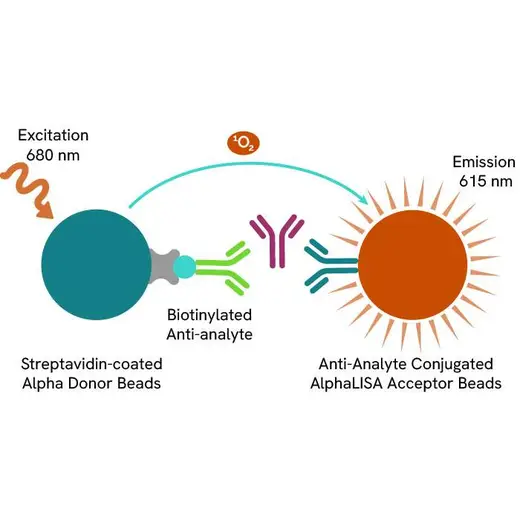
AlphaLISA Human Hyaluronic acid Detection Kit, 500 Assay Points


 View All
View All
AlphaLISA Human Hyaluronic acid Detection Kit, 500 Assay Points














The AlphaLISA® Hyaluronic Acid Detection Kit is designed for detection and quantitation of hyaluronic acid in cell culture media or serum using a homogeneous (no-wash steps, no separation steps) assay. The assay shows no cross-reactivity with human collagen Type I, Type II, Type III, and fibronectin.
For research use only. Not for use in diagnostic procedures. All products to be used in accordance with applicable laws and regulations including without limitation, consumption and disposal requirements under European REACH regulations (EC 1907/2006).
| Feature | Specification |
|---|---|
| Application | Protein Quantification |
| Dynamic Range | 0.3 - 3000 ng/mL |
| Limit of Detection | 0.5 ng/mL |
| Limit of Quantification | 2.2 ng/mL |
| Sample Volume | 5 µL |
The AlphaLISA® Hyaluronic Acid Detection Kit is designed for detection and quantitation of hyaluronic acid in cell culture media or serum using a homogeneous (no-wash steps, no separation steps) assay. The assay shows no cross-reactivity with human collagen Type I, Type II, Type III, and fibronectin.
For research use only. Not for use in diagnostic procedures. All products to be used in accordance with applicable laws and regulations including without limitation, consumption and disposal requirements under European REACH regulations (EC 1907/2006).







AlphaLISA Human Hyaluronic acid Detection Kit, 500 Assay Points







AlphaLISA Human Hyaluronic acid Detection Kit, 500 Assay Points







Product information
Overview
Formats:
- Our 100 assay point kit allows you to run 100 wells in 96-well format, using a 100 µL reaction volume (10 µL of sample).
- Our 500 assay point kit allows you to run 500 wells in 96-well or 384-well format, using a 50 µL reaction volume (5 µL of sample).
- Our 5,000 assay point kit allows you to run 5,000 wells in 96-well or 384-well format, using a 50 µL reaction volume (5 µL of sample).
Features:
- No-wash steps, no separation steps
- ELISA alternative technology
- Sensitive detection
- Broad sample compatibility
- Small sample volume
- Results in less than 3 hours
- Half the time of an ELISA assay
Hyaluronic Acid (HA), also known as hyaluronan or hyaluronate, is a large molecule (MV> 500KD) and is distributed throughout the body connective tissues. HA is an important component of synovial fluid, articular cartilage, skin, and extracellular matrix and play critical role in joints, cartilage, and skin health and the integrity of cells and cell functions. It has been extensively used in skin care products (cosmetic are) and in un-healthy joints treatments. It has been reported that the patients with fibrosis has significant increases in HA in serum and plasma. The present kit is designed to detect hHA in serum, plasma, cell culture supernatants, cell lysate, and tissue homogenates.
AlphaLISA technology allows the detection of molecules of interest in a no-wash, highly sensitive, quantitative assay. In this AlphaLISA assay, a biotinylated human aggrecan binds to the Streptavidin-coated Donor beads and human aggrecan is conjugated to AlphaLISA Acceptor beads. In the presence of the analyte, the beads come into close proximity. The excitation of the Donor beads causes the release of singlet oxygen molecules that triggers a cascade of energy transfer in the Acceptor beads, resulting in a sharp peak of light emission at 615 nm.
Specifications
| Application |
Protein Quantification
|
|---|---|
| Automation Compatible |
Yes
|
| Brand |
AlphaLISA
|
| Detection Modality |
Alpha
|
| Dynamic Range |
0.3 - 3000 ng/mL
|
| Limit of Detection |
0.5 ng/mL
|
| Limit of Quantification |
2.2 ng/mL
|
| Product Group |
Kit
|
| Sample Volume |
5 µL
|
| Shipping Conditions |
Shipped in Blue Ice
|
| Target |
Hyaluronic Acid
|
| Target Class |
Biomarkers
|
| Target Species |
Human
|
| Technology |
Alpha
|
| Therapeutic Area |
Oncology
|
| Unit Size |
500 Assay Points
|
Image gallery






AlphaLISA Human Hyaluronic acid Detection Kit, 500 Assay Points






AlphaLISA Human Hyaluronic acid Detection Kit, 500 Assay Points






Video gallery

AlphaLISA Human Hyaluronic acid Detection Kit, 500 Assay Points

AlphaLISA Human Hyaluronic acid Detection Kit, 500 Assay Points

Resources
Are you looking for resources, click on the resource type to explore further.
Guide to How Cellular Actors of the Tumor Microenvironment Challenge Immunotherapies
Since the early 2000s, significant scientific...


How can we help you?
We are here to answer your questions.






























